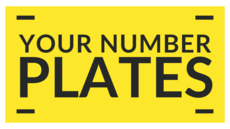1. Introduction – Why Number Plate Knowledge Matters
A number plate is more than an identifier; it is a legal requirement and a key component in road safety and enforcement. Misunderstandings about rules can lead to costly mistakes.
2. What Is the Legal Size and Shape of UK Number Plates?
Standard plates measure 520mm x 111mm for most vehicles, though motorcycles and certain imports may use smaller formats. Plates must remain rectangular and flat for clarity.
3. What Colours Are Permitted for Front and Rear Plates?
The law requires black characters on a white background for the front and black characters on a yellow background for the rear. Both must be reflective for visibility.
4. Which Font Must Be Used on UK Number Plates?
The DVLA mandates the Charles Wright typeface for all plates. This ensures uniformity and legibility for both human observation and camera systems.
5. What Is the Correct Spacing Between Characters?
Characters must have an 11mm gap between them, and there must be a 33mm space between the two halves of the registration. Any deviation is illegal.
6. Are 3D and 4D Plates Legal in the UK?
Yes, if they follow DVLA specifications for size, font, spacing, and reflectivity. Non-compliant variants risk fines or MOT failure.
7. Can I Have My Name or a Word on My Number Plate?
Yes, through a private plate purchase. However, the format must remain within DVLA rules—creative spelling may be used within legal constraints.
8. How Do I Get a Private or Personalised Number Plate?
They can be bought from the DVLA, private dealers, or at auctions. Once purchased, they must be registered to your vehicle via DVLA transfer procedures.
9. Do I Need Special Paperwork to Buy a Number Plate?
Yes. Proof of identity and entitlement to the registration is required, such as a V5C logbook or retention document, to prevent fraud.
10. Can I Transfer My Number Plate to Another Vehicle?
Yes. Plates can be transferred between vehicles you own or placed on retention until ready to assign. A DVLA application is necessary.
11. What Happens to My Plate When I Sell My Car?
If not transferred before sale, the plate stays with the vehicle. To keep it, you must put it on retention before ownership changes.
12. Are There Different Rules for Classic and Vintage Vehicles?
Yes. Vehicles registered before 1 January 1980 may display traditional black plates with silver or white characters.
13. What Is the British Standard Mark and Why Is It Required?
It’s the BS AU 145e marking that ensures the plate meets durability, reflectivity, and legibility standards. It must also display the supplier’s details.
14. Are Show Plates Legal for Road Use?
No, unless they meet all DVLA standards exactly. Decorative plates with altered fonts or backgrounds are for off-road or display purposes only.
15. What Are the Penalties for Using an Illegal Plate?
Fines can reach £1,000. You may also fail an MOT and risk plate withdrawal or vehicle seizure in extreme cases.
16. How Does ANPR Technology Read My Plate?
Automatic Number Plate Recognition cameras scan and process plate images in milliseconds, cross-referencing them with insurance, tax, and crime databases.
17. Can Foreign Vehicles Use Their Plates in the UK?
Yes, for up to six months in any 12-month period, provided the vehicle is road-legal in its home country and meets UK safety standards.
18. How Do I Replace a Lost, Stolen, or Damaged Plate?
You must order from a DVLA-registered supplier, presenting proof of identity and entitlement. Stolen plates should be reported to the police immediately.
19. What Are the Latest DVLA Rules for 2025?
BS AU 145e remains in force, covering reflectivity, durability, and design standards. Enforcement has intensified with ANPR integration across more regions.
20. Conclusion – Staying Compliant on the Road
A legal, well-maintained plate is essential for every driver. Adhering to DVLA standards ensures safety, avoids penalties, and keeps vehicles identifiable for all the right reasons.

